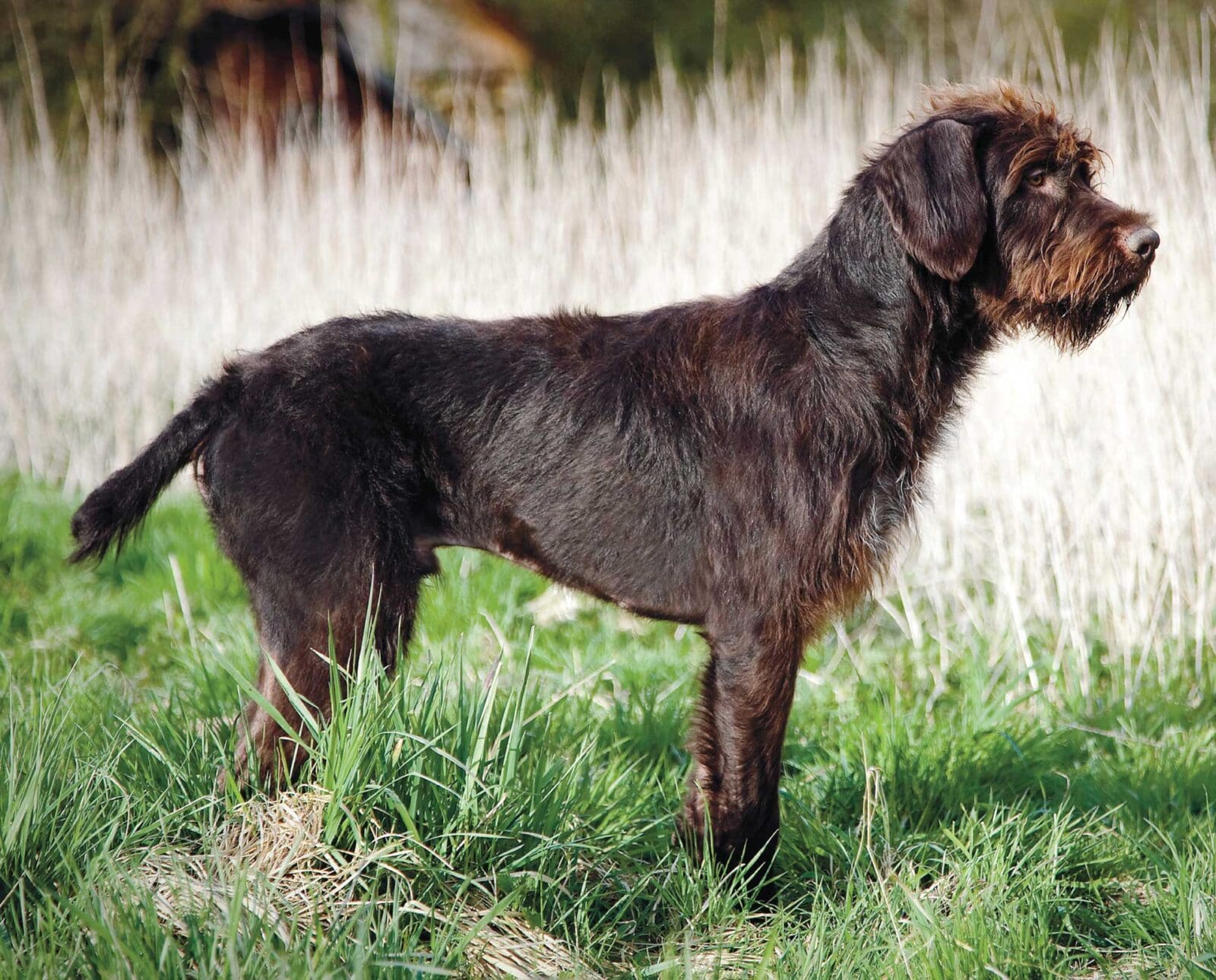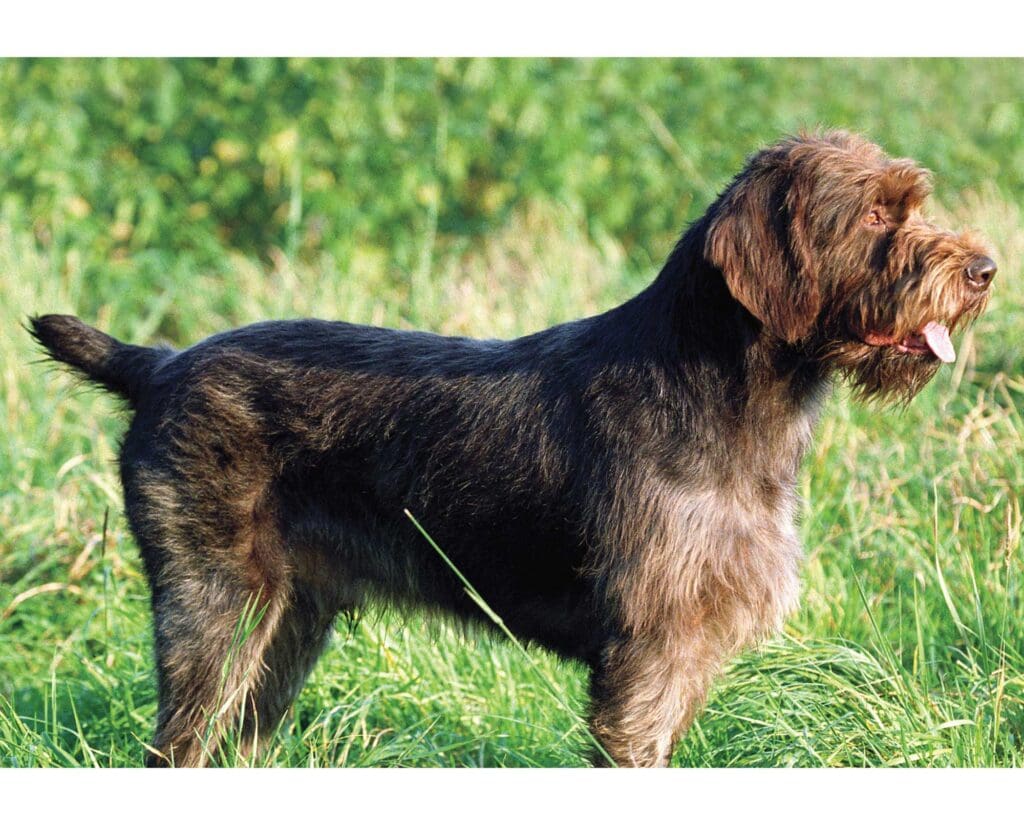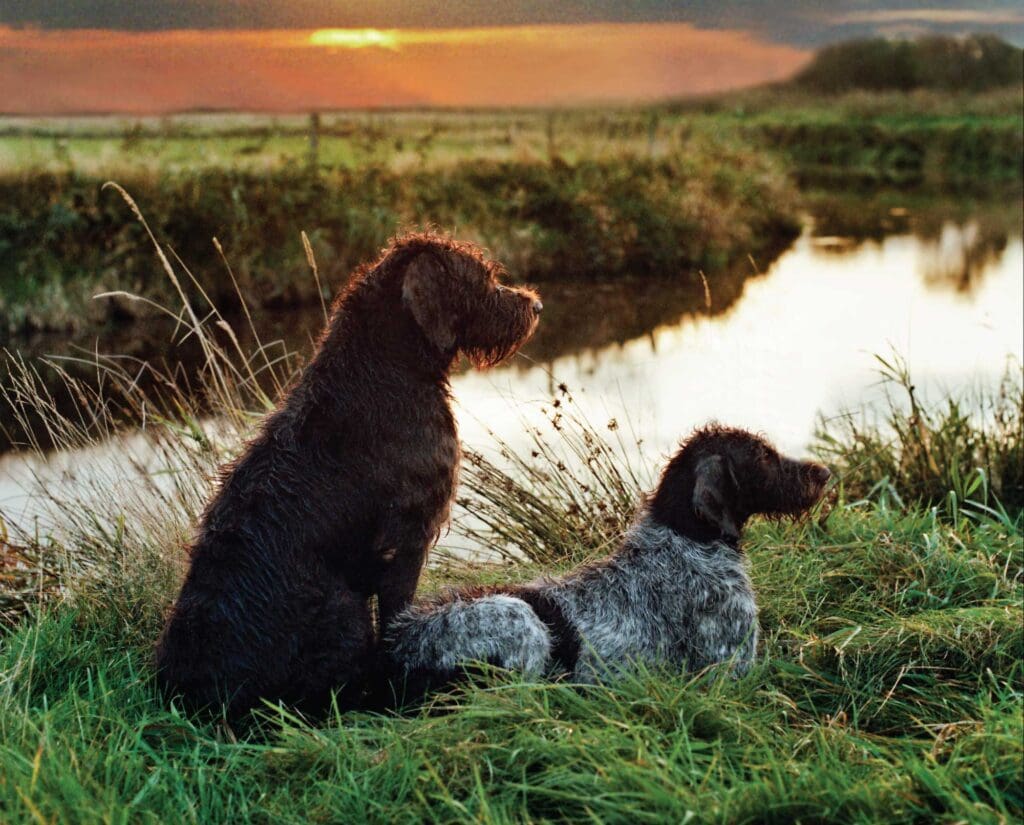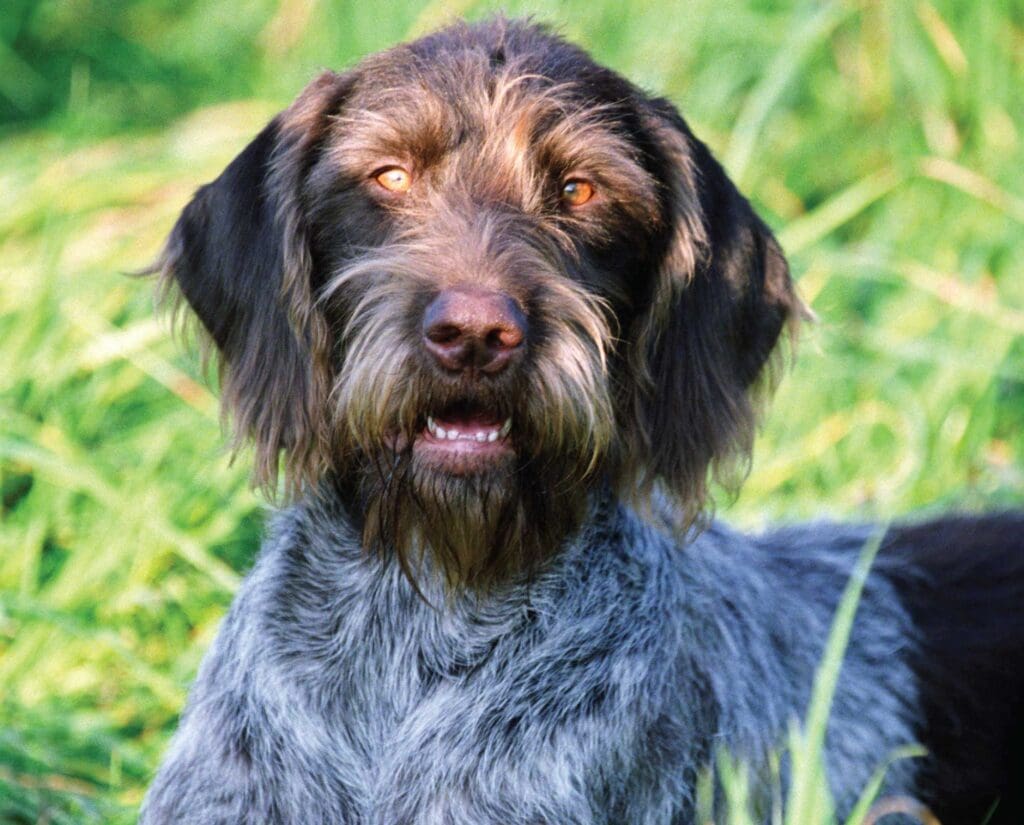Home » Hunting Dogs » Stichelhaar – German Rough Haired Pointer: Dog Breed Information, Form, Function, and History
Stichelhaar – German Rough Haired Pointer: Dog Breed Information, Form, Function, and History

From their home base in Winnipeg, Craig Koshyk and Lisa…
The Stichelhaar (German Rough Haired Pointer) is a rough-and-tumble hunting dog that is probably the least modernized and rarest of all the German pointing dog breeds
When I first started to photograph dogs and compile notes for Pointing Dog, Volume One: The Continentals, I chose to study the better known breeds since it was much easier to find information on them. And, besides, I knew where to find hunters who owned some. But when I started looking into the more obscure breeds, things got a bit trickier. Not only was solid information harder to find, but tracking down owners or breeders of some breeds proved to be difficult. In the case of the Stichelhaar, not only did it take some digging, I also needed a bit of luck to finally see one in the flesh.
At some point in every book or article explaining how the German Wirehaired Pointer was developed, a breed known as the Stichelhaar is mentioned. Some German Wirehaired Pointer histories even provide a brief description of the Stichelhaar’s appearance or hunting ability, but most don’t even offer that. In fact, I’ve even read that the Stichelhaar was an extinct dog breed. So I had a heck of a time finding information on the breed and could not even confirm that is was still around. The only illustrations I could find were old paintings or fuzzy black and white photographs in long out of print magazines and books. After a while, I started to think that maybe the Stichel-haar really was extinct.
Then, in 2001, I attended a hunt in northern Germany organized by Hans Schmidt, a renowned breeder of long haired Weimaraners. While there, I asked him if he knew anything about the Stichelhaar. Expecting him to tell me that the breed was extinct, I was stunned when he replied, “Oh, yes, there are a number of them in the area. I see them sometimes when I am out hunting. They are strong hunting dogs–a very old breed you know.” He then told me that a Stichelhaar breeder lived not too far away from him and suggested that we call him to arrange a meeting! Twenty-four hours later, I was at the home of Elso Kratzenberg, the secretary of the Deutsch Stichelhaar Verein.
Standing in Herr Kratzenberg’s driveway, we exchanged handshakes and introductions and took a few minutes to discuss the kinds of photos I wanted to take. Once we had agreed on a plan, he let his dogs out of the house and into the yard.
As the two big, rough-and-ready dogs came bounding up toward us, I couldn’t help feeling like the scientist in Jurassic Park when he laid eyes on a real-life dinosaur. Finally, right there in front of me, were living, breathing, tail-wagging Stichelhaars, a breed I thought had gone the way of the dodo bird.

Stichelhaar Form
It is easy to mistake a Stichelhaar for a German Wirehaired Pointer or even a Wirehaired Pointing Griffon. All three are medium-sized, well-built hunting dogs with rough, liver and white coats, beard and a moustache. Upon closer inspection, however, differences can be seen.
Stichelhaars can be up to 2 or 3 cm taller than German Wirehaired Pointers. In addition, the Stichelhaar coat is usually shorter than a Griffon’s, and may be somewhat harsher than a GWP’s. The head is also different. It is more rounded and has a less pronounced stop than either the German Wirehaired Pointer or the Griffon.
The Stichelhaars I’ve seen were fairly large but very athletic. One male in particular had a very old school look to him. He was big-boned and had fairly long, low-set ears.
After he had been swimming for a few minutes, I asked the owner if I could touch the coat to see how thick it was. The topcoat was very harsh and the thick undercoat was almost dry to the touch.
Size of the Stichelhaar
Males: 23.5-27.5 inches (60-70 cm) and 60-74 pounds
Females: 23-26.5 inches (58-68 cm) and 55-70 pounds
Stichelhaars can be quite substantial dogs.
With a maximum height of 70 cm, they are one of the tallest Continental pointing breeds, at least in principle. The latest list of approved stud dogs shows that the average height for males is in the region of 65 cm.
Coat of the Stichelhaar
The Stichelhaar’s coat is similar to the coat of other wire-haired breeds, and perhaps a bit harsher.
Permitted coat colors are: Brown, with or without white chest patch; Brown roan, with or without brown patches; Light roan, with or without brown patches.

Character of the Stichelhaar
Stichelhaars are string, vigorous dogs with a lot of prey drive. They are known to be very “sharp” on predators and fearless when it comes to working in heavy cover or when pursuing large game such as boar. But they are also said to have a laid-back personality and the ability to work with the sort of calm determination required of a forester’s dog.
When I meet with breed experts, one of the questions I always ask is: “What is one thing that you would like people to know about the breed?” When I put the question to Elso Kraztenberg, secretary of the Deutsch Stichelhaar Verein, he answered with one word: “Ruhe.” The word means “calm” and, in this context, he meant that the one thing the breed should be known for is a calm, cool and collected character.
Stichelhaar and Protection
The Stichelhaar has always been considered a true forester’s dog and selected for a strong protective nature. However, there are no formal tests conducted at the club level to evaluate this aspect of the breed. Nevertheless, the breed still enjoys a reputation as a good guard dog.
Training Stichelhaars
Stichelhaars are said to be relatively easy to train. Their somewhat calmer, more laid-back character may make them well suited to less experienced handlers.
Stichelhaar Populations
Throughout its history, the Stichelhaar has struggled with a chronically low population. Even now, breeders only produce about 40 pups worldwide in a good year. Now the breed faces a crisis that threatens its very existence. A controversial crossbreeding program involving the Cesky Fousek has split the club in two.
Stichelhaar Health Issues
In addition to all the usual health issues faced by other gundog breeds, alopecia, a sort of genetic pattern baldness, seems to be on the increase in some Stichelhaar lines. Dental problems and temperament issues such as gun-shyness and nervousness have also been identified.

An In-depth History of the Stichelhaar
In 1882, Mr Franz Bontant presented the first Stichelhaars at an international dog show in Hanover, Germany. The Delegate Commission used the opportunity to declare the breed independent, and Germany got its first national wire haired pointing breed. But the question on the minds of many was, and still is, “How did the Stichelhaar come to be?”
Anyone keen on developing a rough-haired breed of versatile gun-dog in 19th century Europe did not have to look very far to find the basic building blocks. For the Wirehaired Pointing Griffon, Pudelpointer and German Wirehaired Pointer, documents still exist that offer a fairly good idea of what kinds of dogs were used to create them. The origin of the Stichelhaar, on the other hand, has always been a mystery.
In the early days, three theories were proposed. One held that the breed was the result of crosses between Italian Spinoni and smooth-coated German pointing dogs. Another, proposed by Franz Bontant, who actually called his dogs Hessian Rough-beards, held that the Stichelhaar was an ancient breed from central Europe. Other experts believed that it was simply a rough-haired version of the German Shorthaired Pointer and they thought that the rough coat had developed due to the colder climate of northern Germany.
Supporters of this third theory even managed to have the following line included in the 1883 German stud book (Volume IV): “The Stichelhaar was originally a variety of our smooth-coated dogs. Because of this, the first standard for the Stichelhaar was based on that of the GSP. The only real difference was that the Stichelhaar had a rough coat.
Then, in 1888, after much debate, supporters of the three competing theories came to an agreement. They published an official statement reversing their previous declarations. They now said that the Stichelhaar was actually a rough-haired version of the old German Hühnerhund (bird dog), and by no means a rough-haired variety of the GSP.
They based their decision mainly on the arguments presented by Dr. Hans Kadich, a well-regarded expert of the day. Apparently, Kadich had analyzed the head shapes of various breeds and somehow concluded that the Stichelhaar was an ancient German dog. Today it is obvious that his so-called studies were nothing more than the kind of racist pseudoscience that was in vogue at the time. But supporters of the Stichelhaar accepted them as valid and used them to remove the Wirehaired Pointing Griffon-a dog they considered to be a French mongrel-from the stud book the two breeds shared in the late 1800s.
In 1892, Club Stichelhaar was formed. At first, it kept its own registry in which the Stichelhaar was listed separately from the Wirehaired Pointing Griffon. But, from 1907 to 1913, during a short-lived period of international cooperation between breeders of all the rough-haired breeds, Stichelhaars were registered in the Griffon stud book founded by Eduard Korthals.
After 1913, with nationalism rising to a near fever pitch, Stichelhaar breeders once again began registering their dogs separately. They also attempted to remove the traits they felt had crept into the breed through crosses to Griffons. They came up with extremely stringent breeding requirements and even prohibited such things as an overly long beard or hair overhanging the ridge of the nose or eyebrows that did not curl in just the right way.
They held fast to their belief that by breeding Stichelhaars without resorting to “foreign” blood, they could improve the breed. Inevitably, this quickly led to a dangerously limited gene pool. Even worse, many Stichelhaar breeders left the club to work with others who were developing the German Wirehaired Pointer, and they took some of their best dogs with them. In the end, the Stichelhaar ended up on the outer margins of the gundog world due to the nar-row-minded policies of the club and the extremely severe selection process breeders clung to in order to keep the breed “pure”.
Throughout the 1920s and ’30s, a small number of Stichelhaars continued to be bred and the club somehow managed to hang on while other German breeds advanced by leaps and bounds.
The Stichelhaar did manage to gain a good reputation for “sharpness” on predators and was prized by some foresters for its strong protective instinct. But World War II and the subsequent division of Germany proved nearly fatal to the breed. At the war’s end, only a handful of Stichelhaars remained, mainly in northwest Germany where a breed club was reformed in the early 1950s. In East Germany, a few people continued to breed Stichelhaars and, when Germany was reunited in the 1990s, all Stichelhaars came to be represented by one club.
Unfortunately, in Germany today, the breed continues to lag far behind all the other German pointing breeds. In fact, it is now facing what may be its biggest challenge ever.
From their home base in Winnipeg, Craig Koshyk and Lisa Trottier travel all over hunting everything from snipe, woodcock to grouse, geese and pheasants. In the 1990s they began a quest to research, photograph, and hunt over all of the pointing breeds from continental Europe and published Pointing Dogs, Volume One: The Continentals. The follow-up to the first volume, Pointing Dogs, Volume Two, the British and Irish Breeds, is slated for release in 2020.






What is it with breeders that want to always cross breed in the Cesky Fousek bloodline? They did it to Wirehaired Pointing Griffons to “Better” the breed, when there actually was no problem that called for it. And if Ceskys are such a great breed saving dog, why am I not seeing more of them in the field? This trend is troubling.